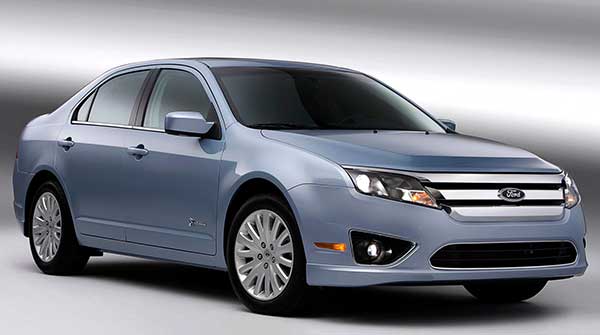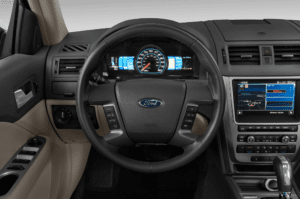Owners tend to keep the 2010 Ford Fusion Hybrid forever, given their reliable and economical performance

 Ford Fusion Hybrids of the 2010 vintage can be in short supply. Owners tend to keep them forever.
Ford Fusion Hybrids of the 2010 vintage can be in short supply. Owners tend to keep them forever.
Introduced in 2010, the Fusion Hybrid was powered by a 2.5-litre four-cylinder gas engine mated to a pair of electric motors and a constantly variable transmission. The engine featured Atkinson technology, which basically lowers the compression and makes the power stroke a bit longer during the combustion cycle.
The electric motors were housed in the vehicle transaxle and fed by a nickel metal hydride battery pack. This system was similar to that found in the Escape Hybrid but was tweaked and more compact in size.
It also allowed the Fusion Hybrid to qualify as a “full” hybrid – i.e., one that will run on battery power alone.
Total combined power output for the Fusion Hybrid was 191 horsepower and 155 horsepower with just the internal combustion engine. In 2010, its Transport Canada fuel consumption ratings were an impressive 4.6 litres/100 km in town and 5.4 litres/100 km on the highway. Ford claimed a range of some 1,127 kilometres on a full tank of fuel. This was probably a little optimistic.
One area where the Fusion excelled was in its instrumentation. A full set of gauges front and centre informs the driver about things like current fuel consumption, how much electricity the accessories are consuming, engine RPMs and when the internal combustion engine is about to cut in.

A cluster-of-leaves graphic that grows and sheds, depending upon how you drive, also helped the driver keep an eye on fuel economy. Drive in an environmentally sensitive way with a light throttle foot and you were rewarded with a nice full bouquet of leaves; put the pedal to the metal and you got nothing but a stalk.
There’s a reasonably high equipment level here, with things like power driver’s seat, Sirius satellite radio, air conditioning, ABS, one-touch power windows, remote keyless entry, and a full complement of front and side airbags all standard. Options included heated front seats, leather interior, remote start, moonroof, voice-activated navigation system, blind spot side detection system and a rear video camera.
Like its non-hybrid stablemate, the Fusion Hybrid offered a fair amount of interior elbow room, but with 334 litres of luggage space, the trunk was a little on the small side.
Transport Canada had no safety recalls specifically for the Fusion Hybrid, but non-hybrid versions may have issues with their automatic transmission shift linkage, seat mechanism and wheels. This latter problem is usually found when non-Ford service personnel over-tighten the studs on aluminum wheels when remounting the tires. This can cause the wheels to crack.
Interestingly, the U.S. National Highway Traffic Safety Administration had zero safety recalls or technical service bulletins on file for the 2010 Fusion Hybrid. They did, however, have six complaints on file from owners. These ranged from problems with a faulty engine throttle valve that won’t allow the car to be driven at speeds over 70 km/h, to the aforementioned wheel stud problem, to an apparently defective brake line vacuum line, to my personal favourite: “driver was in small local shopping centre, he turned into parking space, applied brake, when car accelerated over curb onto sidewalk and through front of building.” Uh-oh.
Consumer Reports liked the regular Fusion for this year, giving it their “Good Bet” designation. They also seemed to favour the Hybrid, and it received a better-than-average used car verdict.
For what it’s worth, the 2011 and 2012 versions (essentially the same car) fared better. Problem areas seem to be the transmission and fuel and electrical systems. Some comments from owners: “gassing up once a month is super,” “the clever gaining and losing of leaves on the dash have made me a more gas mileage oriented driver,” “feels like a regular car, not a hybrid,” and “ I’m getting an excess of 500 miles (800 km) between fill-ups.” One complaint that cropped up regularly is the small trunk and lack of fold-down rear seats.
Marketing researcher J.D. Power, meanwhile, was also a fan. It gave the 2010 Fusion Hybrid its highest ratings for overall performance, design and overall dependability. It seemed to fall a bit short in terms of accessories quality and design, but otherwise, it was all sweetness and light.
If you manage to find a 2010 Fusion Hybrid, you can expect to pay around $8,000 to $11,000.
2010 Ford Fusion Hybrid
Original base price: $31,999
Engine: 2.5-litre, four-cylinder with AC permanent magnet electric motor
Horsepower/torque: 155 horsepower, 191 horsepower combined; 136-foot pounds
Transmission: CVT
Fuel economy (litres/100 kilometres): 4.6 city/5.4 highway, regular gas
Some alternatives: Toyota Camry Hybrid, Honda Insight, Nissan Altima Hybrid, Chevrolet Malibu Hybrid, Toyota Prius, and VW Jetta TDI.
Ted Laturnus has been an automotive journalist since 1976. He has been named Canadian Automotive Journalist of the Year twice and is past president of the Automotive Journalists Association of Canada (AJAC).
For interview requests, click here.
The opinions expressed by our columnists and contributors are theirs alone and do not inherently or expressly reflect the views of our publication.
© Troy Media
Troy Media is an editorial content provider to media outlets and its own hosted community news outlets across Canada.
